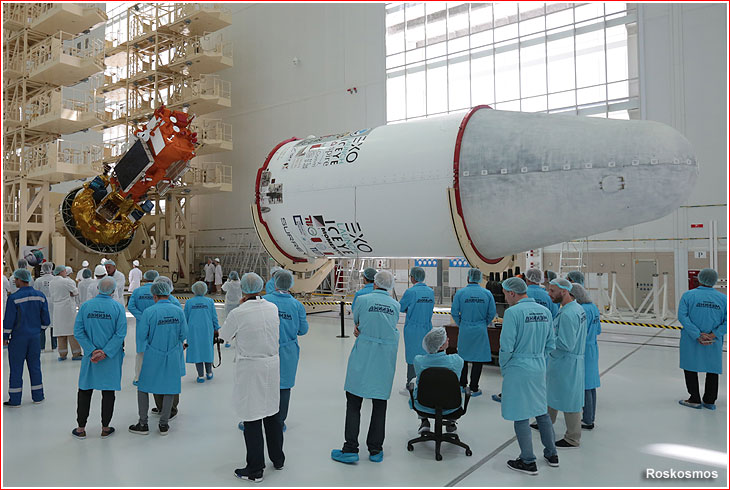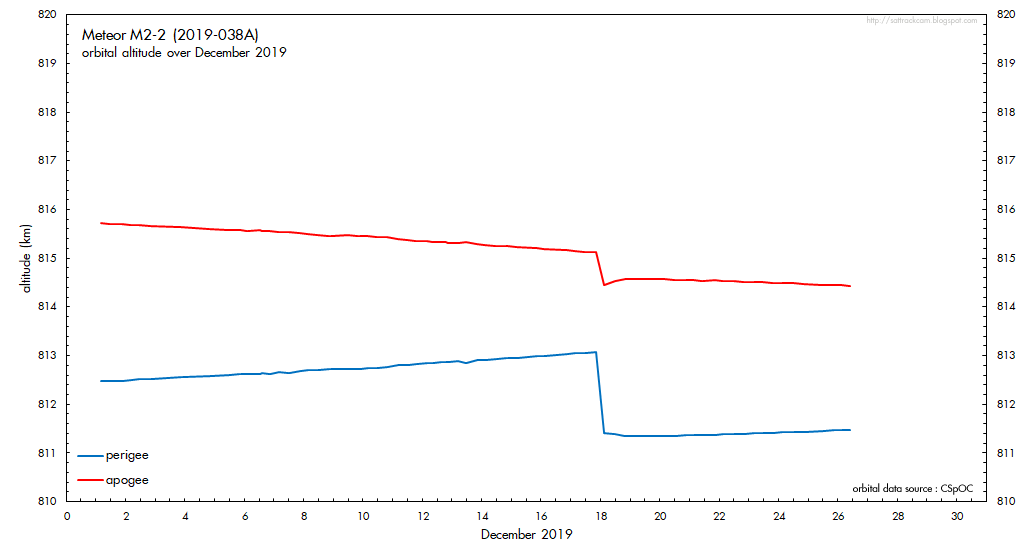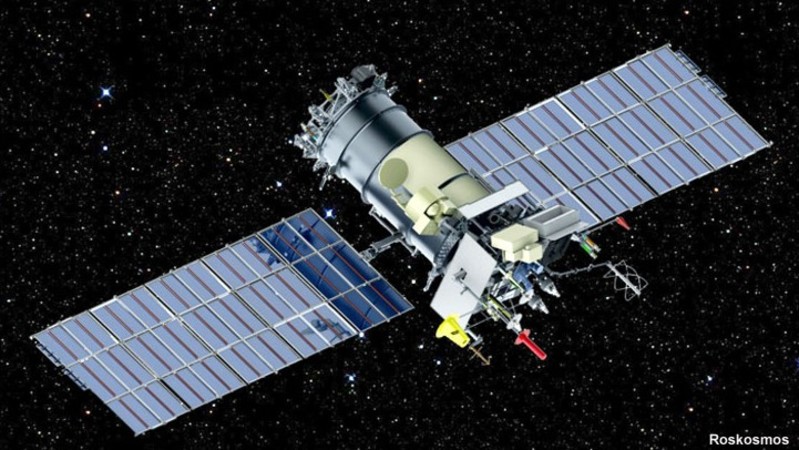For humans and satellites alike, making a living in space is hard. First, there’s the problem of surviving the brief but energetic and failure-prone ride there, after which you get to alternately roast and freeze as you zip around the planet at 20 times the speed of sound. The latter fact is made all the more dangerous by the swarm of space debris, both natural and man-made, that whizzes away up there along with you, waiting to cause an accident.
One such accident has apparently led to the early demise of a Russian weather satellite. Just a few months after launch, Meteor-M 2-2 suffered a sudden orbital anomaly (link to Russian story; English translation). Analysis of the data makes it pretty clear what happened: the satellite was struck by something, and despite some ground-controller heroics which appear to have stabilized the spacecraft, the odds are that Meteor-M 2-2 will eventually succumb to its wounds.
Weather Watchers
To call the Meteor-M series of satellites unlucky is something of an understatement. Originally conceived as a four-satellite constellation, the birds were to be equipped with the latest in imaging and sensing instruments and launched into sun-synchronous polar orbits. They would afford Russia scientists complete coverage of the vast country every couple of days, with special emphasis on monitoring conditions in the Arctic regions.
Original plans called for a series of satellites called Meteor-3M to be launched between 1998 and 2000, but for unknown reasons the satellites were never built. The plan morphed into the Meteor-M series, which aimed to be in service by 2010. The first satellite, Meteor-M1, was launched in 2009, but spent years in an “experimental operation” mode before being listed as in full service. After only two years of nominal operation, instruments began to fail, including an X-band radar designed to monitor sea ice and a critical infrared imager. In 2014, the satellite’s attitude control system failed too, rendering the entire spacecraft useless.

To address some of the instrument deficiencies, an improved series of satellites, the Meteor-M2 series, was designed. The first of these, Meteor-M 2-1, made it to the launch pad at Vostochny Cosmodrome in November of 2017, but didn’t make it much further. An error in the navigation system programming led the upper stage to fire its engines when it was pointed the wrong way, dropping the satellite payload into the North Atlantic.
Meteor-M 2-2 fared much better in its July 2019 launch. The 2,900 kg spacecraft, along with 33 other small satellite payloads, rode to orbit successfully aboard a Soyuz-2-1b. The programming errors that doomed its predecessor had been corrected, and Meteor-M 2-2 entered its assigned orbit and began returning data. It seemed like the satellite was on its way to a long and useful career as a weather watcher.
Trouble Upstairs
The textbook operations of Meteor-M 2-2 wouldn’t last long, though, and as is often the case, an amateur radio operator was among the first to notice. Dmitry Pashkov (R4UAB), a satellite monitoring fan, had been capturing images from weather satellites for years. But when he tried to find Meteor-M 2-2 on December 18, 2019, all he got was dead air. It seemed like the satellite was gone, and once he announced his findings, it wasn’t long before other satellite watchers pieced together a story, one that would eventually be confirmed by Roscosmos, the Russian space agency.
Based on the data, it appears that Meteor-M 2-2 was struck by a micrometeoroid – either a natural chunk of space rock or some piece of man-made debris. The SUV-sized satellite was sent spinning violently out of control by the impact. It immediately put itself into a safe mode to protect its instrumentation and give ground controllers time to regain control, which they eventually did. Subsequent analysis of the orbital data revealed that the satellite had also lost two kilometers of orbital altitude immediately after the impact.

Such a violent disruption of a satellite as big as Meteor-M 2-2 would imply a large, very energetic collision. But that would likely break the satellite into multiple pieces, and there’s no evidence that anything like that happened. That means the impactor was small, which appears at odds with the outsized effect it had on the spacecraft. That leaves operators considering whether the impact penetrated a pressurized part of the satellite’s hull. That could explain the drastic change in attitude and altitude.
Unfortunately, it could also mean the end of Meteor-M 2-2’s mission. Many of the instruments aboard the satellite require constant temperatures to work, and the electronics controlling the bird may now be exposed to the vacuum of space. Roscosmos has regained control of the spacecraft and damped down its spin, and there are even reports that an X-band signal from the satellite has been detected.
With a depressurized hull, the spacecraft is likely doomed to follow in the sad footsteps of its predecessors. It’s yet another in a long string of failed or marginal weather satellites, the passing of each which is mourned by the satellite monitoring community. There are still plenty of satellites up there providing realtime weather and climate imagery, but the likely loss of Meteor-M 2-2 shows just how dangerous it can be up there.
















“Have been” ( in title ). Feel free to delete comment.
It’s still there, staff probably went on vacation. I completely missed it too. Easy mistake.
Got it, thanks!
And while you’re at it: “…making a living is space is hard.” That first “is” should probably be “in”. :-)
Thats the russian language. Theres lots of languages that dont have articles and other connectors and russian is one of them. The translator may insert something that is there to fill the space when translating to english which uses them.
Anyone else think some nation-state has a vested interest in deniably causing problems for these “weather satellites?”
Elon Muskovia?
China you mean? It deliberately attacked a satellite and created a lot of debris. Not very responsible, was it?
Of stated uses, highest commercial value is agricultural planning I would think.
Well at least the satellite will live up to its name “Meteor-M 2-2”. It can be an actual Meteor now.
Ha! Ha-Ha! Ha-Ha-Ha! What a clever joke.
Diagram shows that staellite had been slowly loosing speed in al least six hours. So, speed lost is definitely not a direct result of hypotethic collision. Closest speculation could be that satellite lost speed and began to rotate as a result of decompression flow through the small hole. There could be at least two reasons for hole appearance: some object (micrometeorite or space junk) and factory defect (somebody drilled undesired hole in spaceship again). So, space junk is not even most probable reason. So why it is in header?
Those diagrams are not orbital speed on the Y axis, they’re orbital altitude. Blue is perigee, red is apogee. Since the orbit is slightly elliptical, it’s normal to see the graph vary cyclically over time, and since this graph only covers 25 or so days, we don’t see a full cycle. What’s not normal is the sudden loss of two kilometers on the 18th from both perigee and apogee – actually, apogee only appears to have lost one km, but still, it’s sudden and violent.
As for the rest, sure, it could be a manufacturing defect, but I tend to take an Occam’s Razor approach to these things. Micrometeoroid collision seems like a far simpler explanation than either intentional prelaunch sabotage or some kind of Star Wars micro-impactor sent up by an adversary.
Orbital altitude directly depends on orbital velocity. So, if orbit changed it means satellite speed changed. Just that simple.
As for factory defect, it rare means intended sabotage. Just poor parts, materials and work quality. If you find out current salaries of russian engineers and assembly staff, you would be amased of how all that russian things fly at all. I’ll bet on 40/40% for natural micrometeoroid and factory defect, 19.99% of unintended orbit correction engine firing and only 0.01% for that politically profitable now space junk theme.
That’s some clever meteoroids that only target birds with big eyes ;)
Most meteoroids in Earth orbit (<2000km) are ‘space junk’, that is, they have an artificial rather than natural origin. As they have the same effect on a spacecraft, most space agencies etc. just group it all into one category.
These sun synchronous orbits precess incrementally by about 1 degree per day to maintain the desired attitude. https://en.wikipedia.org/wiki/Sun-synchronous_orbit
Sadly, this almost inevitably leads to orbital junk collisions as it gradually sweeps the entire 600-800 Km altitude in which it operates. This might take 10 years?
The other theory is the USA has tuned some multiple impactors (50-100 or so) to occupy the same space on slightly varied parameters. These can be made radar stealthy, as well as dense to max the damage.
Maybe I am a conspiracy theorist – maybe not???
It would be a deniable – what – who – me situation typical of the state of affairs between them?
Any intentional collisions in space will create more bits and pieces to cause more collisions. Allowed to happen, this would create a grinder ring around the Earth not suitable for any craft. Which country would benefit? It would lead to a kind of detente, if we can’t make use of space, neither can you. Which country doesn’t need satellites for peaceful purposes but has the ability to launch? North Korea perhaps?
I wonder whether this might have been debris from the Indian ASAT test last year. As I recall, the target satellite in that test was in a polar orbit, and while something like 90% of the trackable debris from that event de-orbited within a few days, some is still up there, presumably in the same polar orbit, plus or minus some altitude. Plus there was a lot of debris from that test that was too small to track that’s probably still up there.
Total speculation on my part, haven’t seen any official fingerpointing on that yet. It’s not even terribly likely, given all the other crap we’ve left floating around up there. Just seems odd that there was this big event that was widely publicized not even a year ago, and then a brand-new satellite gets zapped by something.
In original story nothing about junk. A micrometeorite was
US satellites use the exact same orbits as the Russian ones (and everyone else), so any debris they cause will affect them just as much (if not more, as the US has more satellites).
To cause a change in perigee of 2 km would require a delta-V of less than one meter per second at that altitude.
If it was struck by random earth-orbital debris at, say, 7-10 km/s, that orbital flotsam would need to be around a hundred grams to impart that amount of momentum. That would have an impact energy equal a couple of sticks of dynamite, which I’m guessing would be enough to promptly disable the satellite.
If it was struck by a smaller micrometeor at faster sun-orbital speeds (so, with similar momentum), then the energy would be several times greater, almost certainly killing the bird.
Conversely, if it just bumped into a larger chunk of junk in a similar (sun-synchronous) orbit with similar momentum to a fast, small chunk but at relatively low speed, that would be enough to give it a tumble and maybe break a few things, but the energy would be much less, and less likely to promptly kill it.
Since it appears to be still kind of alive and phoning home, my bet is the impactor was something relatively big (tens of kilograms) in a very similar orbit.
So Tesla spaceman has bazooka?
Did that glove lost from a Gemini capsule just take out a satellite? Lot of other possibilities too… including some hobbyist items, oft Arduino based. Or Scotty’s ashes? We seriously litter every single place we’ve ever gone! And there already are plenty of naturally occurring objects to worry about so the logic is it’s OK to add more? Or…. that’s it’s so vast that it’s OK to add more?
Your Grandchildren are gonna be up there! And at some point we’re gonna have to catch and drag that car back down.
Given the appalling state of the Russian space industry, and the media which is a state propaganda machine, my bet is on faulty build or operation. Russia will blame anything rather than their own fault, orbital debris is a convenient and plausible excuse.
I mean, they launched a module with a badly patched hole in it, then obliquely suggested it might be sabotage from the ISS crew!
” It immediately put itself into a safe mode to protect its instrumentation and give ground controllers time to regain control, which they eventually did. ”
That’s russian engineering.
American engineering seems to deplete most or all of the fuel due to software errors.
Conspiracy theory: someone put an EmDrive on it, and wanted to see if it worked or not.
Easy enough to do, and the whole thing can be written off as “micrometeor decompression” or slow fuel leak while secretly gathering invaluable data. Last I heard the core unit can be relatively small and fit into a Cubesat so this could have been hidden somewhere on board connected to the power bus.